Story by Sara E. Teller
ROBERTA LUCAS, an expert in expressive arts therapy and dance,has been a resident of Ferndale since 2000. “I live in one of those tiny 1923 cottages you see in Ferndale – some have been added on to but you recognize them when you see them,” she says fondly.
“I like being close to the Woodward Corridor. It’s been amazing to see the down-town area grow and thrive while the neighborhoods continue to support people and families at a range of income levels.”
She owns Environmental Expressions, which “is my business and ‘umbrella’ for the work I do in arts education, arts integration and expressive arts therapy.” Of the name, Roberta explains, “The environment can refer to any place within or outside of us.”
The dance instructor reflects on how she first developed a passion for integrating the arts with psychology. “As I continued my work as a dance and drama teaching artist I would often hear from teachers: ‘Your work is 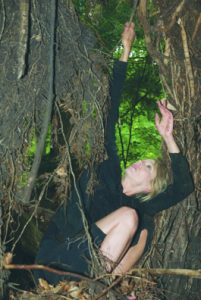 so therapeutic, are you a movement therapist?’ As I continued to dance and perform and teach, I found I was incorporating what I was learning from life/art workshops into classrooms and performances. There is an artful lens to view any and every situation, whether it’s in education, social action, or personal development. When we engage our creativity hand in hand with body expression – there is an opportunity to shift and move in new ways physically and metaphorically.”
so therapeutic, are you a movement therapist?’ As I continued to dance and perform and teach, I found I was incorporating what I was learning from life/art workshops into classrooms and performances. There is an artful lens to view any and every situation, whether it’s in education, social action, or personal development. When we engage our creativity hand in hand with body expression – there is an opportunity to shift and move in new ways physically and metaphorically.”
Roberta has been a special instructor at Oakland University since 2000. “I teach a class for elementary education majors, integrating dance and drama with core curriculum,” she says. “I also teach a creative dance for children class to dance majors.” She is also an O.U. alum. “I studied communications, theater, and received a B.A. and a minor in dance.”
Roberta says that even in her student days, she had quite a bit of exposure to the performing arts. “Even when I was an undergrad I had many opportunities to per-form and work with professionals in the arts. At O.U. I was a member of the dance musical-theatre ensemble Other Things and Company directed by Carol Halsted. We toured elementary schools presenting original productions written, composed and created by O.U. Students.”
She completed residencies at Hutzel Recovery for Women and Affirmations. “My intern work at Hutzel involved working with women in recovery,” she explains. “I ended up at Affirmations and going through their facilitator training in the ‘90s. I was preparing for my graduate program. My family had been affected by
HIV/AIDS, like others. At that time, there was so much that was unknown and misunderstood.”
She is still very involved with The Wolf Trap Institute for early learning through the arts. The Institute “first hired me as a Michigan artist, and then I joined the National Teaching Artist Roster in 1994,” she explains, adding that she “was teaching residencies across the country with opportunities to teach in England and Greece. They hire professional performing artists to carry the work into the class-room. It’s a great collective of fellow teaching artists, and now we have that in Detroit as well.”
Detroit Wolf Trap is available at Living Arts, a non-profit organization that engages Detroit youth and teaches transformative experiences in the performing, visual, literary and media arts. “I was hired as a teaching artist by Living Arts in 2008. I am the founding affiliate director of Detroit Wolf Trap at Living Arts. This was an exciting opportunity to bring Wolf Trap back to Michigan. I provide professional development for educators, and coaching for teaching artists.”


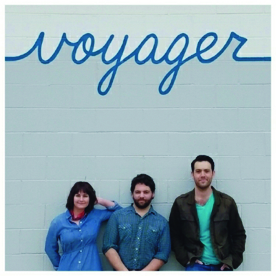
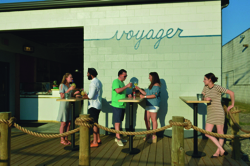 ile and stylish gold trim. The color palette and vaguely Scandinavian-inspired design gives off a mid-century modern vibe, bolstered by the vintage school chairs that double as seating. The 1,400-square-foot space seats 40, with 12 seats at the long bar and 28 in the dining room, which is split from the bar by a low divider sporting individual drink shelves, or “niches,” instead of a rail. Because of the restaurant’s petite size, the single glass-paneled garage door provides ample natural light. It is rolled up in warmer months to add a few more seats on the indoor/outdoor patio.
ile and stylish gold trim. The color palette and vaguely Scandinavian-inspired design gives off a mid-century modern vibe, bolstered by the vintage school chairs that double as seating. The 1,400-square-foot space seats 40, with 12 seats at the long bar and 28 in the dining room, which is split from the bar by a low divider sporting individual drink shelves, or “niches,” instead of a rail. Because of the restaurant’s petite size, the single glass-paneled garage door provides ample natural light. It is rolled up in warmer months to add a few more seats on the indoor/outdoor patio.
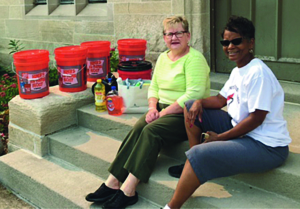

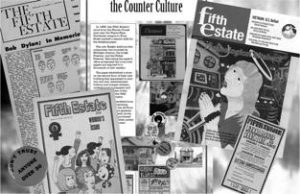 forward function. On radio, as soon as the spot break comes, boom, you hit the button for your second favorite station. But, if you’re like me, you probably read not only every article in this paper to see who is doing what and what is going on, but pay attention to the ads since they are a source of information around the community as well.
forward function. On radio, as soon as the spot break comes, boom, you hit the button for your second favorite station. But, if you’re like me, you probably read not only every article in this paper to see who is doing what and what is going on, but pay attention to the ads since they are a source of information around the community as well. and entertainment a seclusive affair. It’s not just about finding a book, or picking one out – talking about books, browsing for something with a librarian’s recommendation, or get-ting to compare something you read in a group or one of our book clubs, can not only enhance your enjoyment, but bring you deeper understandings of the world, of history, of the human experience.
and entertainment a seclusive affair. It’s not just about finding a book, or picking one out – talking about books, browsing for something with a librarian’s recommendation, or get-ting to compare something you read in a group or one of our book clubs, can not only enhance your enjoyment, but bring you deeper understandings of the world, of history, of the human experience.